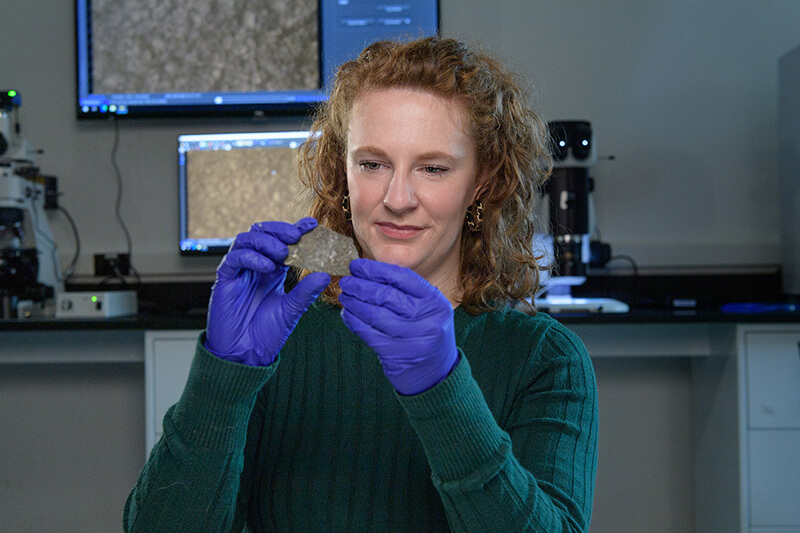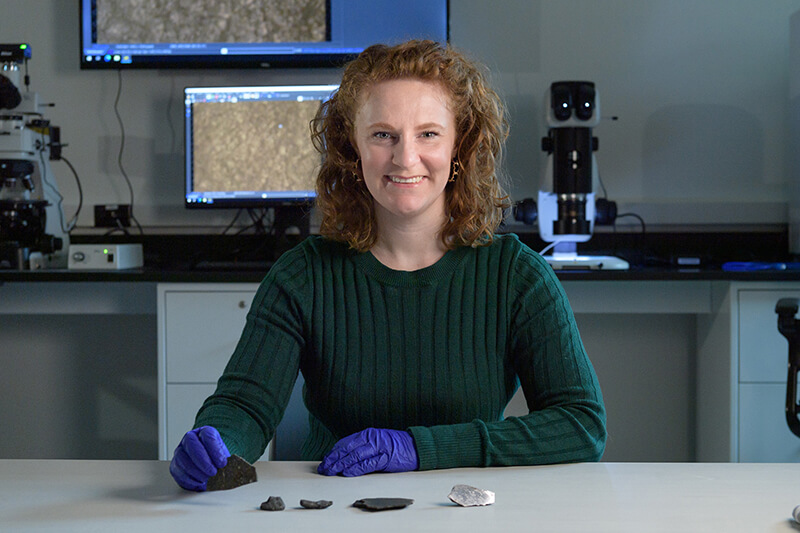WEST LAFAYETTE, Ind. — A fireball lit up the Australian sky in the first week of December, as Japan’s Hayabusa2 asteroid explorer sent a capsule containing pieces of nearby asteroid Ryugu down to the Earth’s surface.
The capsule and its cargo were met with international cheers, including those of Michelle Thompson, a Purdue scientist who will be one of the first researchers in the world to study the samples. Thompson, professor of planetary sciences, was recruited to the Hayabusa2 science team to study the composition and molecular structure of materials returned from the asteroid.
Researchers believe that the surface of asteroid Ryugu contains organic molecules. This is only the second successful return of an asteroid sample to date, and it is the first successful retrieval from a carbon-bearing asteroid. The first asteroid sample was collected from a stony-type asteroid named Itokawa, completed by the first Hayabusa explorer in 2010. Both the Ryugu and Itokawa asteroid exploration missions were run by the Japan Aerospace Exploration Agency. In 2023, NASA’s OSIRIS-Rex mission will return samples from another asteroid thought to bear organic molecules.
Why study asteroids? After humans have landed men on the moon and rovers on Mars, what is the benefit of visiting the airless structures that show up in disaster films more often than the news?
Asteroid study provides information valuable for planetary defense, potential resource collection and the future of space exploration, Thompson said.
“Understanding the behavior of asteroids, where they are and what they’re made of, is really important for planetary protection,” she said. “We can learn where they’re going, what forces are acting on them, what may change their orbit, what may send them into an Earth-crossing path and what might not.”
Some asteroids may prove to be sources of elements that are not accessible or readily available on Earth, and though asteroids are improbable targets for permanent colonies, they could prove a useful means of advancing space exploration.
Michelle Thompson, a Purdue University professor of planetary sciences, displays samples of meteorites from many different asteroids that were found on Earth. She will be one of the first researchers in the world to study samples of asteroid Ryugu (not pictured) that Japan’s Hayabusa2 asteroid explorer recently returned to Earth. (Purdue University photo/John Underwood)
“Certain near-Earth asteroids have been proposed as targets of human exploration, not as permanent settlements, but for storage or refueling platforms to assist longer missions,” Thompson said.
Studying asteroids and other planetary bodies relies largely on images and readings collected from a distance. Thompson’s research is fundamental to reading datasets gathered from remote sensing technologies.
Thompson studies a process called space weathering, which describes the effects of interplanetary space on planetary bodies that do not have a protective atmosphere. She and her students replicate harsh conditions of space, such as solar wind and high-velocity impacts, so that they can correctly identify and understand the chemistry of samples brought back from airless bodies.
Because asteroid surfaces do not weather the same way as Earth, re-creating these processes in a lab is essential to understanding the images and samples returned from asteroids and other airless planetary bodies.
“Dust particles and energetic ions from solar wind can cause changes in the chemistry or composition of the surface materials and of their atomic-level microstructures. These affect the optical properties that we see in data collected from remote sensing spacecraft,” Thompson said of the importance of understanding space weathering. “We can’t interpret the data properly if we don’t understand this process.”
Change in airless planetary surfaces is the focus of the LEAPS lab, which Thompson runs in the
Department of Earth, Atmospheric, and Planetary Sciences. Her team is running space weathering tests relevant to their upcoming study of the Ryugu samples, which will be unpacked and catalogued by JAXA before being distributed to the science teams. Thompson said she expects to receive materials sometime in the next fall.
Thompson is an active researcher on a number of ongoing sample return missions, including other asteroids and the moon. She and her students are preparing to study samples of asteroid Bennu collected by NASA’s
OSIRIS-REx mission, and she has worked extensively on samples collected from asteroid Itokawa during the first Hayabusa mission.
Thompson has studied lunar samples from nearly every Apollo mission. This includes a project started last year on a previously untouched subsurface sample collected during the Apollo 17 mission, which was commanded by Purdue alumnus Eugene Cernan in 1972. The Apollo 17 samples were kept in storage with the hopes that future research methods and technologies would offer new insight into the materials, and they were distributed as part of NASA’s
Apollo Next-Generation Sample Analysis program.
Thompson, who worked at NASA before coming to Purdue, has an appreciation for understanding all aspects of mission design as well as training the next generation of scientists. Earlier this year, she received a NASA Early Career Fellowship in recognition of her commitment to sharing her expertise. The funds allowed her to purchase state-of-the-art equipment for the LEAPS lab and to begin developing a training series that she hopes to share with researchers throughout the field.
“We are in a rare moment in planetary science right now, with samples coming back from two asteroids and another from the moon, plus investigating samples from the 1970s that haven’t been opened yet,” she said. “It’s a good time to be in planetary science and even better to be doing so at Purdue.”
About Purdue University
Purdue University is a top public research institution developing practical solutions to today’s toughest challenges. Ranked the No. 5 Most Innovative University in the United States by U.S. News & World Report, Purdue delivers world-changing research and out-of-this-world discovery. Committed to hands-on and online, real-world learning, Purdue offers a transformative education to all. Committed to affordability and accessibility, Purdue has frozen tuition and most fees at 2012-13 levels, enabling more students than ever to graduate debt-free. See how Purdue never stops in the persistent pursuit of the next giant leap at
https://purdue.edu/.
Writer: Christy McCarter,
mccarter@purdue.edu
Media contact: Amy Patterson Neubert,
apatterson@purdue.edu
Source: Michelle Thompson,
mthompson@purdue.edu



